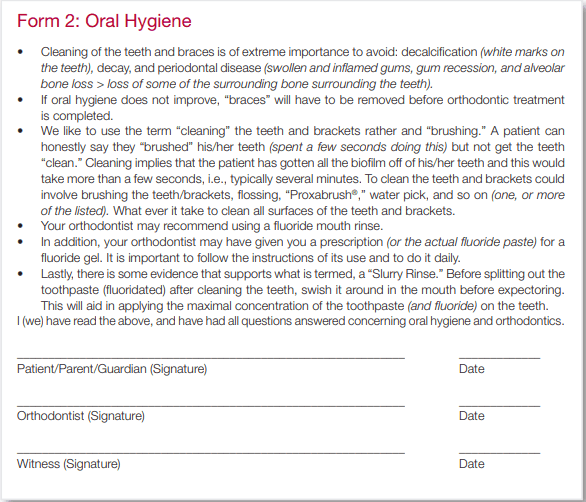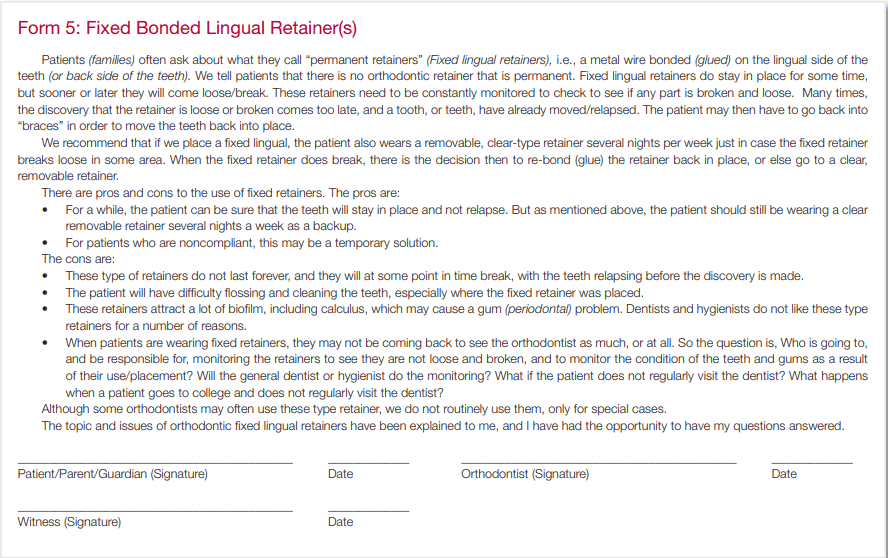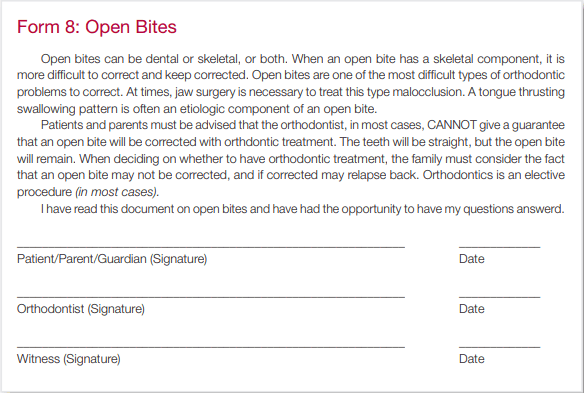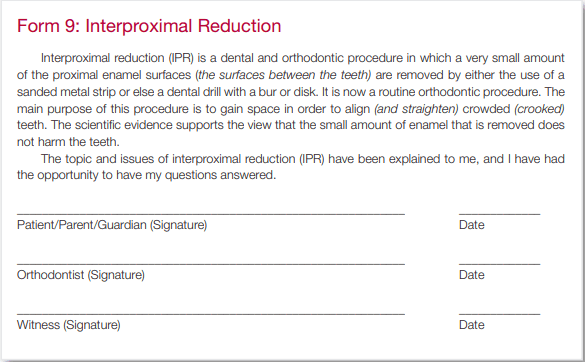Drs. Donald J. Rinchuse and Dara L. Rinchuse suggest some helpful information on informed consent
The American Association of Orthodontists (AAO) has many patient “release” forms that are available to members. Examples include Medical and Dental History Forms, Consent for Treatment, Patient Informed Consent, Patient Declines Treatment, Transfer Form, Refunds, Mouth Guard Release Waiver, Photo Release, Premature Removal of Braces, Bisphosphonates Cautions, TADs, Lasers, Impacted Teeth, and so on. The above cited AAO Forms can be divided into various categories such as Histories, Consents, Transfer Form(s), Supplemental Informed Consent Forms, Waiver and Release Forms, and so on. The AAO forms are found on the website under “Practice Management” and then under “Practice Management Forms and Materials.” The AAO forms are valuable to the practicing orthodontist and can be an important part of a risk management program. The AAO Informed Consent Form, Premature Removal of Appliances, and the Supplemental Form for Impacted Teeth, are particularly useful. Incidentally, we (first author and colleagues) published an article1 on “impacted teeth,” which was then adopted by the AAO to develop the AAO’s Supplemental Form for Impacted Teeth. It should be mentioned that the clear aligner companies have their own informed consent documents.
Prior to electronic records, it was quite easy to have the patients/guardians sign their names in the hard copy “Progress Notes” that they were informed of a particular event for that day. Arguably, it is more difficult to get patient/guardian signatures of acknowledgment and understanding nowadays with digital records. In this digital age, signed patient forms can be scanned and then placed in the patient’s permanent records.
“Patient informed consent” is not a one-time event. Topics and issues that are specifically relevant for each patient should be mentioned and discussed many times over the course of a patient’s treatment. The risk management experts advise orthodontists to document whenever possible.
In addition, the informed consent laws vary from state-to-state. For example, there was a recent Pennsylvania Supreme Court Case, Shinal v. Toms, 162A.3d 429 (Pa. 2017), which clarifies a practitioner’s duty to obtain informed consent, and importantly, the non-delegate nature of it.2 The Court held in Shinal that “a physician cannot rely upon a subordinate to disclose the information required to obtain informed consent.”2 The application of this law to dentistry and orthodontics is that the informed consent dialogue must be “a direct, face-to-face, conversation between the dentist/orthodontist and the patient/parent/guardian, as only then can the dentist/orthodontist be confident that the patient understands the risks, benefits, likelihood of success, and alternatives.”2
Supplemental forms covering various aspects of orthodontics that are component sections of the general AAO Informed Consent Document can be important makings of a risk management program. That is, the supplemental forms expand on, and edify, specific topics covered in the general AAO Informed Consent Document. The forms are ancillary to a signed “AAO Informed Consent” document. Supplemental forms can be especially important today with orthodontists seeing more and more patients, as orthodontic practices get large and larger (in size, and each orthodontist owning more practices), as well as the consideration of more corporate type orthodontic practices.
The authors have developed nine additional “Supplemental Informed Consent” Forms, which are not found in the AAO documents library. The nine Supplemental Informed Consent Forms deal with the following topics: root resorption, oral hygiene, enameloplasty, importance of retainers, fixed lingual bonded retainers, lower jaw growth, patient pretreatment contract, open bites, and interproximal reduction. The documents are found in Forms 1 through 9.
Patients/parents/guardians are asked to sign the forms to acknowledge that they have read and understand the information. These nine forms are additions to the orthodontist’s/assistant’s typed/written comments placed in the patient’s progress notes that attest that a discussion took place relevant to a particular topic/issue(s). If the issue is one of lack of cooperation, such as poor oral hygiene or lack of retainer wear, having the parent/patient sign a formal document can at times motivate positive change. The signed form puts the family on notice that things have to change, or else there will be consequences.
The forms are meant to be examples. It is best that the forms be modified and edited to abide by specific state informed consent laws, and best suit each practice’s particular needs. (Please read the disclaimer at the end of this article.) Each orthodontic practice can decide on how and when these forms are applicable. It should also be mentioned that there are some educational (and instructional) materials available dealing with many of the topics addressed in the forms in this article. However, they are not written and structured as supplemental informed consent documents.
We have limited the number of supplemental informed consent forms for this publication to nine. However, we have created additional forms that represent all of the sections of the AAO Informed Consent Document. These additional forms include such topics as missing upper laterals incisors (to open or close space), “pegged-shape” lateral incisors (whether to enlarge), early treatment (Phase I), wisdom teeth (to extract, and when), jaw surgery, extractions, TMD, risks on removal of clear brackets, and so on. In addition, we have removed pictures from the forms for this publication that visually illustrate the topic for each of the nine forms.
Form 1: Root Resorption
Form 1-Root Resorption is covered in the AAO Informed Consent document under the same heading, “Root Resorption.” This form provides a little more detail than that found in the AAO document. Form 1 can be used in a number of situations. For instance, if a patient is at a greater risk for root resorption (severe overjet, extended length of treatment, has some pre-existing root resorption, has impacted maxillary canines that may be erupting into the maxillary lateral incisors, etc.), this form may be of particular usefulness.

Form 2: Oral Hygiene
Oral Hygiene (Form 2) is to a limited extent covered in the AAO Informed Consent document in the following sections: Decalcification and Dental Caries, Periodontal Disease, and Results of Treatment. It should be mentioned that there is an AAO supplemental informed consent Form for “periodontal disease,” but it is not for oral hygiene. Form 2 is useful in instances where the patient’s attention to, and cooperation with, oral hygiene is questionable, and this could include prior to orthodontic treatment. Importantly, Form 2 covers the situation when the patient is showing signs of decalcification and periodontal disease.

Form 3: Enameloplasty
Enameloplasty (Form 3) is not directly addressed in the AAO Informed Consent document. There is a section on Occlusal Adjustment, which covers the topic of removing enamel, mostly from the posterior teeth, as a means to adjust the occlusion/bite. In addition, in the Occlusal Adjustment section, there is a sentence that discusses interproximal reduction to flatten surfaces between the teeth to reduce the possibility of relapse. Enameloplasty, as in Form 3, deals with the common situation when the orthodontist decides to adjust the incisal edges of the upper and/or lower anterior teeth for esthetic and/or functional reasons.

Form 4: Importance of Retainers
The Importance of Retainers (Form 4) is addressed in the AAO Informed Consent document Relapse and Results of Treatment section. Form 4 was designed to highlight to patients and parents the importance of wearing retainers and wearing retainers for a lifetime, irrespective of whether or not they are removable or fixed retainers. The form mentions, “If retainers are not worn for a lifetime, the teeth will move and ‘shift’ back, i.e., relapse.”

Form 5: Fixed Bonded Lingual Retainer(s)
The Fixed Bonded Lingual Retainer(s) (Form 5) is not directly addressed in the AAO Informed Consent document, but the general topic of retainers and relapse are contained in the Relapse section. Patients, and parents in particular, often ask about the fixed lingual retainers. They most often refer to them as “permanent retainers.” The parents ask, “Are you going to use permanent retainers after my daughter’s braces are removed? My neighbor’s son has these type retainers.” Form 5 addresses the pros and cons of fixed retainers.

Form 6: Lower Jaw Growth
Lower Jaw Growth (Form 6) is not directly covered in the AAO Informed Consent document. There are however three sections that might very remotely deal with this topic and issue: Length of Treatment, Orthognathic Surgery, and Non-Ideal Results. Mandibular growth could be an issue in that the mandible can outgrow the maxilla, and this is particularly relevant for boys who grow longer than girls. So a boy with a “prognathic mandibular” growth pattern may develop into a Class III, skeletal and dental malocclusions, even after orthodontics is completed. Form 6 addresses this issue and concern.

Form 7: Patient Pretreatment Contract
Patient Pretreatment Contract (Form 7) is an interesting form. Typically, the parents/guardians are asked to sign releases and contracts with the orthodontist. However, Form 7 is a pretreatment contract (agreement) between the pre-adult patient and the orthodontist. How many times have we orthodontists heard from parents when we are notifying them that their child is not cleaning his/her teeth and braces, or else not wearing their retainers as directed; “Tell it to him/her (the child) because I am tired of telling him/her. He/she does not listen to me, you need to tell him/her!” And, of course we orthodontists, “throw it” right back on to the parents and respond, “I have told him/her.” So, a contract/agreement between the orthodontist and pre-adult patient (and not particularly the parents/guardian) would be of value. This type of contract is not legally binding in the sense that the minor patient is not of legal age to engage into a contract, but nonetheless, this form is useful.
The first author recalls some years ago listening to an audiotape featuring Dr. Moody Alexander. Dr. Alexander spoke about a patient “IRA” (Individual Responsibility Agreement) that the patient signs. The minor patient agrees (IRA) to pay into the fee, his/her own money, if the length of treatment is extended due to poor cooperation. There are other examples of these types of contracts that deal with school work/grades, chores, sports, etc.

Form 7 deals with two important aspects of orthodontic treatment in which patient cooperation is paramount — i.e., oral hygiene and retainer wear. So, even before the first bracket is placed, the patient reads and signs Form 7 that he/she understands the importance of these two aspects of orthodontics. Oral hygiene and retainer wear are discussed in the AAO Informed Consent document under the following sections: Results of Treatment, Decalcification and Dental Caries, and Periodontal Disease.
Form 8: Open Bites
The topic and issues related to Open Bites (Form 8) have been of concern to orthodontists and patients for over a century. This is a reason that the AAO has established a registry for open bite cases submitted by its members. Open bites (particularly if they are both skeletal and dental) are problematic from the viewpoint of the difficulty in correcting them and, then if corrected, to maintain the correction. A tongue thrust swallowing pattern is often an etiologic factor. At times, the only solution for the correction of an open bite, and also a stable result, is orthognathic (jaw) surgery. Open bites are not directly discussed in the AAO Informed Consent document, but the following sections might indirectly relate: Results of Treatment, Length of Treatment, Relapse, and Orthognathic Surgery.

Form 9: Interproximal Reduction
Interproximal reduction (IPR) is, to a very limited degree, discussed in the Occlusal Adjustment section, which specifically deals with IPR as a means to reduce the possibility of relapse by “flattening” the proximal surfaces of the incisors. In this section, it states, “It may also be necessary to remove a small amount of enamel in between the teeth, thereby ‘flattening’ surfaces in order to reduce the possibility of a relapse.” Form 9, discusses IPR in the context of using a metal (sanded) strip and/or a dental drill with a bur or disk (Air Rotor Stripping – ARS) to remove enamel between the proximal contact surfaces of the teeth in order to gain space to align crowded teeth. The orthodontist would have to decide which patients/parents this form would be of use. Most often, a verbal discussion would suffice.

Conclusion
Patient release forms are an integral part of an orthodontist’s patient and risk management protocol(s). The authors have developed nine Supplemental Informed Consent Forms that are in addition to, and complement, the American Association of Orthodontists’ “Informed Consent” document. They include forms for root resorption, oral hygiene, enameloplasty, retention, fixed lingual retainer(s), lower jaw growth, patient pretreatment contract, open bites, and interproximal reduction.
Disclaimer
This article is intended to provide general information and is not intended as legal advice. The nine forms that appear in this article are not held as legal documents. The law, and interpretations of the law, may change, while each factual situation is distinct. The laws on informed consent vary among states and jurisdictions. For legal guidance, orthodontists/dentists/healthcare providers should consult their attorneys. Nothing in this article is to be construed as defining the standard of care for practitioners.
- Rinchuse DJ, Jerrold L, Rinchuse DJ. Orthodontic informed consent for impacted teeth. Am J Orthod Dentofacial Orthop. July 2007;132(1):103-104.
- Montgomery BE, Lontz T. Informed consent update: A new Pennsylvania Supreme Court Directive. Pennsylvania Dental Journal. Jan/Feb 2018;85(1):17-20.
Stay Relevant With Orthodontic Practice US
Join our email list for CE courses and webinars, articles and mores

 Donald J Rinchuse, DMD, MS, MDS, PhD, received his dental degree (DMD) and Master of Science degree (MS) in Pharmacology and Physiology in 1974, a certificate and Master of Dental Science degree (MDS) in orthodontics in 1978, and a PhD in Higher Education in 1985 — all from the University of Pittsburgh. He has been involved in orthodontics for 42 years. Dr. Rinchus is a Diplomate of the American Board of Orthodontics and a manuscript review consultant for several journals, including the American Journal of Orthodontics and Dentofacial Orthopedics. He has 130 publications to his credit, which include 2 books. He has given many lectures and presentations. Dr. Rinchuse is presently in corporate orthodontic practice in Greensburg, Pennsylvania.
Donald J Rinchuse, DMD, MS, MDS, PhD, received his dental degree (DMD) and Master of Science degree (MS) in Pharmacology and Physiology in 1974, a certificate and Master of Dental Science degree (MDS) in orthodontics in 1978, and a PhD in Higher Education in 1985 — all from the University of Pittsburgh. He has been involved in orthodontics for 42 years. Dr. Rinchus is a Diplomate of the American Board of Orthodontics and a manuscript review consultant for several journals, including the American Journal of Orthodontics and Dentofacial Orthopedics. He has 130 publications to his credit, which include 2 books. He has given many lectures and presentations. Dr. Rinchuse is presently in corporate orthodontic practice in Greensburg, Pennsylvania.
